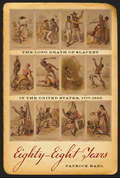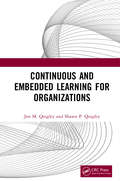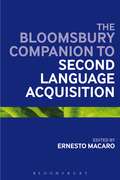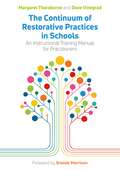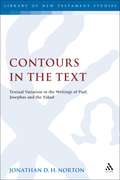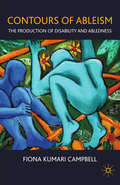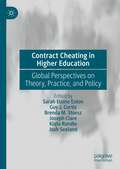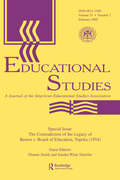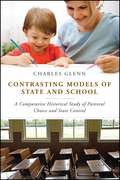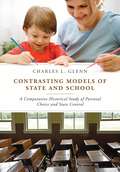- Table View
- List View
Continuing to Engage the Online Learner: More Activities and Resources for Creative Instruction (Jossey-Bass Guides to Online Teaching and Learning #35)
by Rita-Marie Conrad J. Ana DonaldsonContinuing to Engage the Online Learner Contributing to both the theoretical and practical literature, Continuing to Engage the Online Learner expands on the work of Conrad and Donaldson's bestselling Engaging the Online Learner. This next-step resource introduces a new phase to their proven model, the Phases of Engagement, and addresses a wide range of online and hybrid learning environments, technology tools, and communication styles. Comprehensive in scope, the book provides an introduction to the theory of engaged learning and its design, assessment, and management in online and blended learning environments and describes the types of activities that motivate the online learner in each phase of engagement. This down-to-earth resource also includes 50 new and illustrative activities paired with each phase of engagement. In Continuing to Engage the Online Learner Rita-Marie Conrad and J. Ana Donaldson provide relevant and theoretically-sound information to enhance teaching and engage learners, offering a practical handbook for instructors. "Conrad and Donaldson have done it again! Not only have they presented a solid and useful discussion of the phases of engagement, they have brought the theory alive through the presentation of practical activities that would work well in any online or hybrid course." —Rena Palloff, faculty, Fielding Graduate University and author, The Excellent Online Instructor
Continuing Your Professional Development in Lifelong Learning
by Angela StewardNew qualifications for those teaching and training in the FE sector became effective in September 2007. The reform of initial teacher training and the professionalisation of the workforce in the sector require a commitment to engage in continuing professional development. The rational for the book is contained in the argument that improvement of quality in teaching and learning in the sector is not achieved exclusively through short-term external professional development and training activities. Moreover it requires ongoing workplace learning which is long-term in focus and practice-orientated and work-based. In order to improve future practice it needs to be embedded in critical reflection and evaluation of workloads.The purpose of the book is to introduce the notion that there is an opportunity for every teacher to develop their role through their workloads, e.g. workloads are a vehicle for professional development. Ways to achieve this are identified by exploring the practice of experienced and successful teachers. The author then goes on to offers guidelines for promoting constructive practice, which is using the outcomes of reflection in the workplace to achieve role development.
Continuing Your Professional Development in Lifelong Learning: Improvisation And The Theatre (Bloomsbury Revelations Ser.)
by Angela StewardNew qualifications for those teaching and training in the FE sector became effective in September 2007. The reform of initial teacher training and the professionalisation of the workforce in the sector require a commitment to engage in continuing professional development. The rational for the book is contained in the argument that improvement of quality in teaching and learning in the sector is not achieved exclusively through short-term external professional development and training activities. Moreover it requires ongoing workplace learning which is long-term in focus and practice-orientated and work-based. In order to improve future practice it needs to be embedded in critical reflection and evaluation of workloads.The purpose of the book is to introduce the notion that there is an opportunity for every teacher to develop their role through their workloads, e.g. workloads are a vehicle for professional development. Ways to achieve this are identified by exploring the practice of experienced and successful teachers. The author then goes on to offers guidelines for promoting constructive practice, which is using the outcomes of reflection in the workplace to achieve role development.
Continuous and Embedded Learning for Organizations
by Jon M. Quigley Shawn P. QuigleyThere is considerable connection between growth of the personnel in the organization and the ability for the company to compete over time. Looking outside for help training may be required but looking within for opportunities for enhanced training and growth, will foster a continually improving and growing organization. This book examines the opportunities for learning, within the organization and its’ activities, along with the connection to motivation. Additionally, it provides information on the characteristics of organizations that are able to quickly disseminate, along with approaches for improving this distribution of that learning throughout the organization.
Continuous and Embedded Learning for Organizations
by Jon M. Quigley Shawn P. QuigleyThere is considerable connection between growth of the personnel in the organization and the ability for the company to compete over time. Looking outside for help training may be required but looking within for opportunities for enhanced training and growth, will foster a continually improving and growing organization. This book examines the opportunities for learning, within the organization and its’ activities, along with the connection to motivation. Additionally, it provides information on the characteristics of organizations that are able to quickly disseminate, along with approaches for improving this distribution of that learning throughout the organization.
Continuous Teacher Education in Russia: History, Current Practices and Future Directions
by ROZA A. VALEEVA AND AYDAR M. KALIMULLINContinuous Teacher Education in Russia examines the history, recent developments and direction of the modernization of continuous teacher education in Russia, providing a critical insight into the structure and development trajectory of teacher education and offers an analysis of the processes of change that are under way in Russia. Chapters authors discuss the complex system of continuous teacher training, starting with the history of Russia’s teacher education since the 18th century until the present time. The general characteristics of continuous teacher education are then explored, followed by the role of pre-professional development of future teachers in pedagogical classes, the specific Russian phenomenon of the secondary vocational teacher education and the ways of assuring variability and flexibility of the higher teacher education in Russia. Special attention is also paid to the models of novice teacher induction in Russia and the issues of training highly qualified personnel in postgraduate and doctoral studies. This is the definitive English language text on continuous teacher education in Russia, drawing on scholarly expertise in Russia, locating the policies and practices that are discussed within the context of a global reform of teacher education and providing new perspectives that will be of interest to education scholars, policymakers and practitioners on an international scale.
Continuous Teacher Education in Russia: History, Current Practices and Future Directions
by Roza A. Valeeva Aydar M. KalimullinContinuous Teacher Education in Russia examines the history, recent developments and direction of the modernization of continuous teacher education in Russia, providing a critical insight into the structure and development trajectory of teacher education and offers an analysis of the processes of change that are under way in Russia. Chapters authors discuss the complex system of continuous teacher training, starting with the history of Russia’s teacher education since the 18th century until the present time. The general characteristics of continuous teacher education are then explored, followed by the role of pre-professional development of future teachers in pedagogical classes, the specific Russian phenomenon of the secondary vocational teacher education and the ways of assuring variability and flexibility of the higher teacher education in Russia. Special attention is also paid to the models of novice teacher induction in Russia and the issues of training highly qualified personnel in postgraduate and doctoral studies. This is the definitive English language text on continuous teacher education in Russia, drawing on scholarly expertise in Russia, locating the policies and practices that are discussed within the context of a global reform of teacher education and providing new perspectives that will be of interest to education scholars, policymakers and practitioners on an international scale.
The Continuum Companion to Second Language Acquisition (Bloomsbury Companions)
by Bloomsbury PublishingThe Bloomsbury Companion to Second Language Acquisition is designed to be the essential one-volume resource for advanced students and academics. It offers a comprehensive reference resource: it features an overview of key topics in SLA as well the key research methods. It then goes on to look at current research areas and new directions in the field by examining key relationships in the field, including the relationship between first and second language acquisition and the relationship between L2 input and L2 output.It is a complete resource for postgraduate students and researchers working within second language acquisition and applied linguistics.
Continuum Guide to Geography Education
by Graham ButtA reference guide to geography education. Entries, arranged alphabetically, cover: government legislation and reports; famous geography educators; resources; research findings; movements, trends, debates and issues; organizations; and key concepts. An analytical index helps the reader to choose paths through the book, connecting entries.
Continuum Guide to Media Education
by Pat BreretonThis is a unique, comprehensive and authoritative guide to media education in all its aspects - the key concepts, resources, research findings, movements, issues, debates, educators and organizations that characterize the subject.Presented in an easy-to-use, A-Z format, the entries constitute an invaluable one-stop resource for media educators and education students at all levels in this broad, interdisciplinary subject area.
The Continuum Guide to Successful Teaching in Higher Education
by Manuel Martinez-PonsThis definitive resource covers every aspect of teaching in higher education. Particular emphasis is placed on the two main concerns facing professors in North America and the UK today; the growing emphasis on the quality of college teaching and, more specifically, the increasingly demanding nature of the profession, whereby lecturers are forced to teach more students on a greater number of courses. Pons' practical advice is supported throughout by research evidence.
The Continuum of Restorative Practices in Schools: An Instructional Training Manual for Practitioners
by Margaret Thorsborne Dave VinegradAn instructional manual on restorative justice in schools from world-leading experts; this 'how to' guide offers guidance on the issues of carrying out restorative practices once they have been implemented in schools. It includes coping with day-to-day problems and offers worksheets for practical daily use.
Contours in the Text: Textual Variation in the Writings of Paul, Josephus and the Yahad (The Library of New Testament Studies)
by Jonathan D.H. NortonThis is an examination of Paul's possible awareness of the plurality of Ancient Jewish Scripture. Norton-Piliavsky places Paul's work within the context of ancient Jewish literary practice, bridging the gap between textual criticism and social history in contemporary discussions. The author argues that studies of ancient Jewish exegesis draw on two distinct analytical modes: the text-critical and the socio-historical. He then shows that the two are usually joined together in discussions of ancient Jewish literature arguing that as a result of this commentators often allow the text-critical approach to guide their efforts to understand historical questions. Norton argues that text-critical and historical data must be combined, but not conflated and in this volume sets out a new approach, showing that exegesis was part of an ongoing discussion, which included mutually supporting written and oral practices. Norton shows that Josephus' and Dead Sea sectarians' use of textual variation, like Paul's, belongs to this discussion demonstrating that neither Paul nor his contemporaries viewed Jewish scripture as a fixed literary monolith. Rather, they took part in a dynamic exegetical dialogue, constituted by oral as much as textual modes.
Contours of Ableism: The Production of Disability and Abledness
by F. CampbellChallenging notions of what constitutes 'normal' and 'pathological' bodies, this ambitious, agenda-setting study theoretically reinvigorates disability studies by reconceptualising it as 'studies of ableism' focusing on the practices and formations of able-bodiedness to uncover what it means to be 'able' rather than 'disabled'.
Contract Cheating in Higher Education: Global Perspectives on Theory, Practice, and Policy
by Sarah Elaine Eaton Guy J. Curtis Brenda M. Stoesz Joseph Clare Kiata Rundle Josh SeelandThis edited volume—the first book devoted to the topic of contract cheating—brings together the perspectives of leading scholars presenting novel research. Contract cheating describes the outsourcing of students’ assessments to third parties such that the assignments or exams students submit are not their own work. While research in this area has grown over the past five years, the phenomenon has been exacerbated by the COVID-19 pandemic. Themes addressed in this book include the definition of contract cheating, its prevalence in higher education, and what motivates students to engage in it. Chapter authors also consider various interventions that can be used to address contract cheating’s threat to academic integrity in higher education including: assessment practice, education, detection strategies, policy design, and legal interventions.
The Contradiction Between Form and Function in Architecture
by John Shannon HendrixContinuing the themes that have been addressed in The Humanities in Architectural Design and The Cultural Role of Architecture, this book illustrates the important role that a contradiction between form and function plays in compositional strategies in architecture. The contradiction between form and function is seen as a device for poetic expression, for the expression of ideas, in architecture. Here the role of the terms "form" and "function" are analyzed throughout the history of architecture and architectural theory, from Vitruvius to the present, with particular emphasis on twentieth-century functionalism. Historical examples are given from Ancient, Classical, Islamic, Christian, Byzantine, Gothic, Renaissance, Mannerist, and Neoclassical architecture, and from movements in the twentieth century to the present. In addition philosophical issues such as lineamenti, Vorstellung, différance, dream construction, deep structure and surface structure, topology theory, self-generation, and immanence are explored in relation to the compositions and writings of architects throughout history. This book contributes to the project of re-establishing architecture as a humanistic discipline, to re-establish an emphasis on the expression of ideas, and on the ethical role of architecture to engage the intellect of the observer and to represent human identity.
The Contradiction Between Form and Function in Architecture
by John Shannon HendrixContinuing the themes that have been addressed in The Humanities in Architectural Design and The Cultural Role of Architecture, this book illustrates the important role that a contradiction between form and function plays in compositional strategies in architecture. The contradiction between form and function is seen as a device for poetic expression, for the expression of ideas, in architecture. Here the role of the terms "form" and "function" are analyzed throughout the history of architecture and architectural theory, from Vitruvius to the present, with particular emphasis on twentieth-century functionalism. Historical examples are given from Ancient, Classical, Islamic, Christian, Byzantine, Gothic, Renaissance, Mannerist, and Neoclassical architecture, and from movements in the twentieth century to the present. In addition philosophical issues such as lineamenti, Vorstellung, différance, dream construction, deep structure and surface structure, topology theory, self-generation, and immanence are explored in relation to the compositions and writings of architects throughout history. This book contributes to the project of re-establishing architecture as a humanistic discipline, to re-establish an emphasis on the expression of ideas, and on the ethical role of architecture to engage the intellect of the observer and to represent human identity.
Contradictions of Control: School Structure and School Knowledge (Critical Social Thought)
by Linda M. McNeilMcNeil traces the poor quality of high school instruction t the tensions between the social control purposes of schooling and the schools' educational goals.
Contradictions of Control: School Structure and School Knowledge (Critical Social Thought)
by Linda M. McNeilMcNeil traces the poor quality of high school instruction t the tensions between the social control purposes of schooling and the schools' educational goals.
Contradictions of School Reform: Educational Costs of Standardized Testing (Critical Social Thought)
by Linda McNeilFirst published in 2000. Routledge is an imprint of Taylor & Francis, an informa company.
Contradictions of School Reform: Educational Costs of Standardized Testing (Critical Social Thought)
by Linda McNeilFirst published in 2000. Routledge is an imprint of Taylor & Francis, an informa company.
The Contradictions of the Legacy of Brown V. Board of Education, Topeka (1954): A Special Issue of Educational Studies
by Dianne Smith Sandra Winn TutwilerFirst Published in 2005. Routledge is an imprint of Taylor & Francis, an informa company.
The Contradictions of the Legacy of Brown V. Board of Education, Topeka (1954): A Special Issue of Educational Studies
by Dianne Smith Sandra Winn TutwilerFirst Published in 2005. Routledge is an imprint of Taylor & Francis, an informa company.
Contrasting Models of State and School: A Comparative Historical Study of Parental Choice and State Control
by Charles L. Glennchool Choice and the forming of citizens for responsible freedom are two of the most hotly debated topics in educational policy. International comparison offers perspective on the effects of alternative policies. This book profiles historically and currently two countries which give strong support to parental choice (The Netherlands and Belgium) and two others that maintain a strong State role in controlling education (Germany and Austria). Charles L. Glenn draws upon Dutch, French, and German sources to contrast how the Dutch and Belgians came over the 19th and 20th centuries to entrust education to civil-society institutions with strong parental choice, while Germany and Austria maintained a predominant State role in education. Glenn illuminates the implications of these policies and the dangers that can arise when the State uses popular schooling to shape popular beliefs and loyalties. This is essential reading for policy specialists concerned with balancing school autonomy and government oversight, and with debates over parental choice of schools.
Contrasting Models of State and School: A Comparative Historical Study of Parental Choice and State Control
by Charles L. Glennchool Choice and the forming of citizens for responsible freedom are two of the most hotly debated topics in educational policy. International comparison offers perspective on the effects of alternative policies. This book profiles historically and currently two countries which give strong support to parental choice (The Netherlands and Belgium) and two others that maintain a strong State role in controlling education (Germany and Austria). Charles L. Glenn draws upon Dutch, French, and German sources to contrast how the Dutch and Belgians came over the 19th and 20th centuries to entrust education to civil-society institutions with strong parental choice, while Germany and Austria maintained a predominant State role in education. Glenn illuminates the implications of these policies and the dangers that can arise when the State uses popular schooling to shape popular beliefs and loyalties. This is essential reading for policy specialists concerned with balancing school autonomy and government oversight, and with debates over parental choice of schools.


